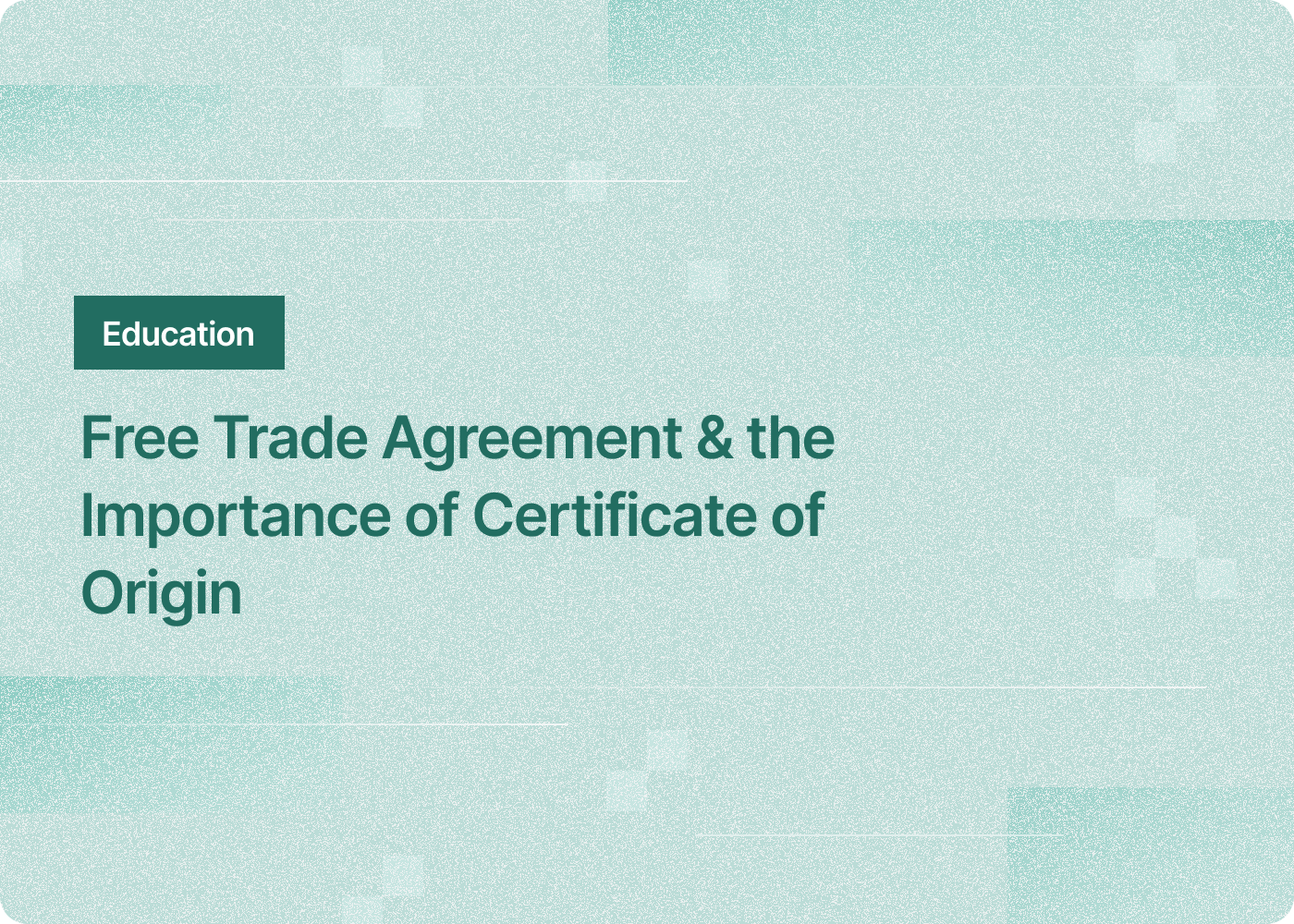In the vast realm of global trade, intricacies abound. And amidst these complexities, the certificate of origin stands as a lighthouse, guiding the seamless exchange of goods across borders. This essential international trade document not only certifies the ‘birthplace’ of goods but also plays a pivotal role in ensuring the right tariffs and trade treatments are applied based on a product’s origin.
But there’s more to the tale. Enter the world of free trade agreements. These agreements, signed between two or more countries, are designed to reduce or eliminate certain trade barriers, offering reduced tariffs or even preferential tariff treatment for goods. Such agreements make international trade more efficient, reducing costs for both businesses and consumers. And central to their proper functioning? The certificate of origin.
Every time a product is shipped internationally, these two elements—free trade agreements and certificates of origin—dance in a delicate duet, ensuring that goods receive the benefits they’re entitled to and that countries can trust the authenticity of imports. Dive with us into this journey, as we decode the intricacies of this trade duo, laying bare their significance in today’s interconnected commercial landscape.
The Certificate of Origin Explained
At the heart of every international trade transaction lies a critical document: the certificate of origin. But what exactly is this certificate, and why does it carry such weight in the realm of global commerce?
What is a Certificate of Origin?
A certificate of origin (often referred to as CO or COO) is an international trade document that attests to the origin of goods in a particular export shipment. It provides proof that the goods were wholly obtained, produced, manufactured, or processed in a particular country. This isn’t just a mere formality; it’s an assertion of a product’s identity and, by extension, the benefits or regulations it might be subjected to.
The Impact on International Trade
In international trade, origins matter. Depending on where a product comes from, it might be eligible for preferential tariff treatment, face specific trade barriers, or be subjected to particular trade remedies. The certificate of origin ensures customs authorities can confidently grant these benefits or apply these measures. It’s a passport for products, offering them passage through the complex landscape of international commerce.
Preferential vs. Non-Preferential Certificates
There are mainly two types of certificates of origin:
-
Preferential Certificates of Origin: These certify that goods are subject to lower tariffs or even exempted from them entirely because they originate from countries that have trade agreements with the importing country.
-
Non-Preferential Certificates of Origin: These do not confer any special treatment on the goods. They’re typically used to enforce measures like anti-dumping duties or countervailing duties, among others.
Each type plays a distinct role in global trade, ensuring products are treated appropriately based on their origins and the trade agreements in place.
Free Trade Agreement – The Cornerstone of Modern Trade
In the ever-evolving tapestry of international commerce, free trade agreements (FTAs) stand out as monumental pillars. These agreements weave together economies, create opportunities, and drive forward the engine of global commerce. But what are they, precisely, and how do they intertwine with the essential certificate of origin?
Understanding the Structure and Intent Behind Free Trade Agreements
Free trade agreements are designed to foster closer economic cooperation between two or more countries. Their primary intent is to reduce or eliminate trade barriers, such as tariffs, quotas, and other trade measures that might hinder the seamless flow of goods and services. By doing so, FTAs create a favorable environment for businesses, leading to:
-
Increased Market Access: Businesses can tap into newer markets with reduced costs.
-
Enhanced Economic Integration: Countries can benefit from shared resources and expertise.
-
Stimulated Economic Growth: By reducing trade barriers, countries can witness an uptick in trade volumes and, consequently, economic growth.
How These Agreements Drive Global Commerce
FTAs act as catalysts for global commerce. They allow countries to specialize in producing goods and services where they have a competitive advantage, leading to efficient resource allocation and optimized production. This not only results in cost savings for producers but also translates to affordable prices for consumers. It’s a win-win that propels the wheels of international trade.
The Synergy Between Free Trade Agreements and the Certificate of Origin
Herein lies the beautiful dance between FTAs and certificates of origin. For a product to benefit from the preferential tariff treatment outlined in an FTA, it must qualify as originating from one of the agreement’s member countries. This is where the certificate of origin steps in. It serves as definitive proof of a product’s eligibility, ensuring it reaps the benefits of the trade agreement. Without this certificate, the myriad advantages of FTAs would remain inaccessible for countless products, making the CO an indispensable player in the symphony of modern trade.
Preferential Tariff Treatment and Its Benefits
Trade isn’t just a mere exchange of goods; it’s orchestrated by a symphony of agreements, certifications, and tariff systems. Preferential tariff treatment is one such instrumental note in the melody of international commerce. But what is it? And how does it harmonize with the crucial certificate of origin?
Introducing the Concept of Preferential Tariffs
At its essence, preferential tariffs offer reduced tariff rates compared to the standard tariffs that a country might charge its trading partners. It’s a way of promoting trade by making goods from certain countries more competitive in price, thanks to these reduced tariffs. This is often an outcome of trade agreements, especially FTAs, where member countries agree to provide each other favorable tariff terms.
The Link Between Preferential Tariff Treatment and Origin Certification
However, to enjoy these preferential rates, there’s a catch: the goods must be proven to originate from the particular country enjoying the FTA. Enter the certificate of origin. This document attests that a particular export shipment is wholly obtained, produced, manufactured, or processed in a particular country, thus making it eligible for preferential tariff treatment. Without this certificate, the goods might not qualify for the reduced tariffs under the FTA.
How Businesses Can Benefit from These Preferential Rates
For businesses, preferential tariffs can mean higher profit margins, as the cost of importing raw materials or finished products is lowered. This advantage can be passed onto consumers in the form of competitive pricing. Additionally, by having a certificate of origin, businesses ensure a smooth customs process, avoiding unnecessary delays or customs formalities. It’s a key to unlocking the myriad benefits of international trade agreements and fostering robust global trade relationships.
The Role of Customs Authorities in the Certificate Process
In the intricate dance of international trade, customs authorities play the pivotal role of gatekeepers. Their mandate not only ensures that trade rules are adhered to but also protects national interests. A vital instrument in their toolbox? The certificate of origin.
The Significance of Customs Authorities in International Trade
Customs authorities are the sentinels at the borders, safeguarding the interests of a nation. They oversee the import and export of goods, ensuring that all trade measures are upheld. Whether it’s implementing trade remedies, verifying tariff classifications, or ensuring proper documentation, their role is indispensable in the seamless flow of global commerce.
How Customs Vet and Verify Certificates of Origin
When goods cross borders, the certificate of origin is like a passport, attesting to their provenance. Customs authorities meticulously check this document, verifying its authenticity against the data elements provided in the commercial invoice or the corresponding electronic certificate. Their keen eyes ensure that the goods indeed qualify for any preferential duty rates they might claim. It’s a rigorous process, with customs officials cross-checking against trade agreements, local chamber databases, and more.
Navigating Challenges and Ensuring Smooth Customs Clearances
But the journey isn’t always smooth. Challenges can arise, from discrepancies in the origin form to issues with stamping certificates. Businesses can preempt these hiccups by ensuring their certificates are in order, seeking assistance from customs brokers, and staying updated with required documentation online. In this digital age, many customs authorities also offer electronic certificates, expediting the process and reducing potential bottlenecks.
Origin Free Trade Agreements – A Deep Dive
As the global landscape of commerce evolves, trade agreements adapt to suit the intricacies of modern exchange. While many agreements revolve around tariffs and restrictions, origin free trade agreements (OFTAs) focus primarily on the geographic birthplace of goods. But what makes them stand apart from the generic trade agreement, and what implications do they have for the world of business?
Exploring the Origin-Focused Nature of Some Free Trade Agreements
At the heart of any origin free trade agreement is the emphasis on the provenance of goods. Where a product is made often influences its tariff classification and preferential treatment in international markets. OFTAs set specific rules for determining a product’s eligibility based on its origin, which can either be “wholly obtained” in one country or “substantially transformed” in two or more countries. This focus on origin ensures that the benefits of the agreement, like reduced tariffs, are genuinely tied to the participating countries.
How They Differ from Broader Trade Agreements
While many trade agreements address a spectrum of issues, from environmental standards to intellectual property, origin free trade agreements are more narrow in scope. They zero in on origin criteria, ensuring goods originating from agreement countries get preferential cos. This makes OFTAs both simpler in design and more stringent in their verification processes, like requiring a specific form of certificate of origin.
Their Impact on Businesses and the Broader Economy
For businesses, OFTAs can be a boon. By taking advantage of these agreements, companies can access reduced tariffs, boosting their competitiveness in foreign markets. Furthermore, for economies, OFTAs can strengthen ties with key trading partners, ensuring a steady flow of goods and fostering mutual economic growth.
Acquiring the Certificate – A Step-by-Step Guide
Securing a certificate of origin is a pivotal task in international trade. This document, critical for goods traversing borders, is deeply ingrained in global commerce. Yet, as straightforward as it may sound, there are intricacies in obtaining the certificate, pitfalls to dodge, and an emerging shift towards a digital paradigm.
The Process Behind Obtaining a Certificate of Origin
-
Documentation Preparation: Start with compiling the required documentation, which typically includes a commercial invoice detailing the export shipment. This invoice provides customs authorities with pertinent data elements, ensuring accurate tariff classification.
-
Submission to a Local Chamber: Submit the documentation to your local chamber or an international chamber of commerce for verification. Many chambers have an origin template to simplify the process.
-
Verification and Approval: The chamber reviews the documents, ensuring the goods wholly obtained in a particular country or sufficiently transformed in two or more countries, qualifying under trade agreements.
-
Receiving the Certificate: Once verified, the chamber issues the certificate, often accompanied by stamping certificates to reinforce authenticity.
Potential Pitfalls and How to Avoid Them
While obtaining a certificate might appear straightforward, there are pitfalls. Mismatched data between the certificate and the commercial invoice or inaccurate origin forms can lead to customs disputes. It’s essential to have an accurate origin document and, where needed, collaborate with a customs broker who’s well-versed with customs formalities.
Transitioning to Digital: The Rise of Electronic Certificates
The digital wave is reshaping the international trade landscape. With electronic certificates becoming prevalent, businesses can secure their certificate in less than a day. This digital format, stamped electronically, eliminates the need for a paper certificate, offering faster shipping solutions and efficient trade facilitation. Most countries are now accepting these electronic certificates, recognizing their efficiency and accuracy.
The Road Ahead for Free Trade and Origin Certifications
As the tapestry of global trade continues to evolve, the threads binding free trade agreements and certificates of origin become even more crucial. The dynamics of international trade are shifting, propelled by technological advances, policy reforms, and a growing emphasis on transparency and fairness.
The future of free trade agreements seems to be moving towards a more inclusive approach, with countries keen on establishing robust partnerships that cater to the unique needs of developing countries, promoting sustainability and ethical practices. This, in turn, will amplify the need for stringent and transparent origin certifications to ensure the veracity of claims and adherence to trade stipulations.
Moreover, the certification processes, as observed, are inching towards a digital transformation. Electronic certificates will likely dominate, speeding up processes, reducing human errors, and bridging the trust gap between trading nations.
In essence, as we navigate this dynamic landscape, the symbiotic relationship between free trade agreements and origin certifications will remain at the forefront, shaping the contours of global commerce.



